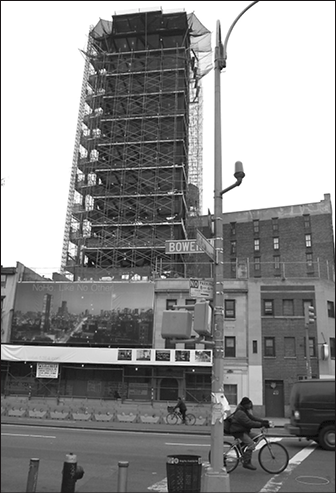By Rebecca Harshbarger
“Peck Moss Group.” “Brack Capital.” “For Sale.” These are some of the signs — and new neighbors — that have been popping up along the Bowery, dismaying local residents, as a new boutique hotel district is burgeoning in a neighborhood rich with history. While college students and tourists flock to the Bowery’s new nightlife attractions, including recently opened bars, such changes are loathed by longtime residents.
“The logic of building these high-rise developments along the historic Bowery is disingenuous,” said David Mulkins, a high school teacher and Bowery-area resident. “This has become an attractive area because of its low-rise, historic character, its thriving arts community and cultural mix,” he said. “All of this is being rapidly destroyed by these high-rise towers. It’s a very sad moment for the history and culture of this city.”
The rate of development has been accelerating in recent years, according to the new ad-hoc Bowery Association Network, or BAN. Some of the major developments include the Bowery Hotel at 335 Bowery — whose rooms start at more than $400 a night — the new AvalonBay buildings centered around Houston St., and the New Museum at 235 Bowery. Up to seven new hotels are being developed on the Bowery very close to its southern Chinatown borders.
“Obviously, the hotels are for tourists and not for residents,” said Esther Wang, from the Committee Against Anti-Asian Violence, or CAAAV.
Many of the city’s Asian-American residents have been concerned about the impact that the Bowery’s gentrification will have on Chinatown, into which the boulevard extends.
“A lot of our tenants who have lived in Chinatown for decades are, unfortunately, going to be priced out of their homes,” Wang said. “Clearly, the effect is going to be extremely negative on the tenants of Chinatown, many of whom are low-income and have lived in the same neighborhood for decades.”
Last year, BAN members first met to trace the course of development and gentrification in the neighborhood. The new group is focused on building strategies to resist development on the Bowery that the group feels is largely negative.
“We need people to understand what’s going on,” said Anna Sawaryn, one of the group’s founders. “People don’t really see the big picture, how quickly it’s going on and the impact this is having on the community.”
The Bowery is both a neighborhood and a street. The street runs from the East Village and Cooper Square in the north to Chatham Square and Chinatown in the south. On either side of the Bowery are Little Italy and the Lower East Side.
“Some of the oldest buildings in the city are on the Bowery,” noted Mulkins. “Before there was a Broadway, the Bowery was the entertainment mecca of the city. Many famous writers, photographers and filmmakers have lived in and taken inspiration from the area. There is a lot of tenant harassment going on, and the massive influx of bars and clubs has dramatically reduced the quality of life in our neighborhoods, in our community.”
BAN members are extremely concerned about the lack of landmarking along the Bowery. The group hopes to hold discussions with local councilmembers about development’s impact on the neighborhood’s quality of life, affecting issues ranging from noise violations and gentrification to changing the overall dynamic of the Bowery. Much of the development is as of right, meaning no special permits or input from the community are needed.
“City planning should really do some planning and take responsibility for the as-of-right zoning,” said Sawaryn. “There are no studies being done, nothing mitigating the negative impact on the community. People are being forced out of their homes. People are afraid.”




































